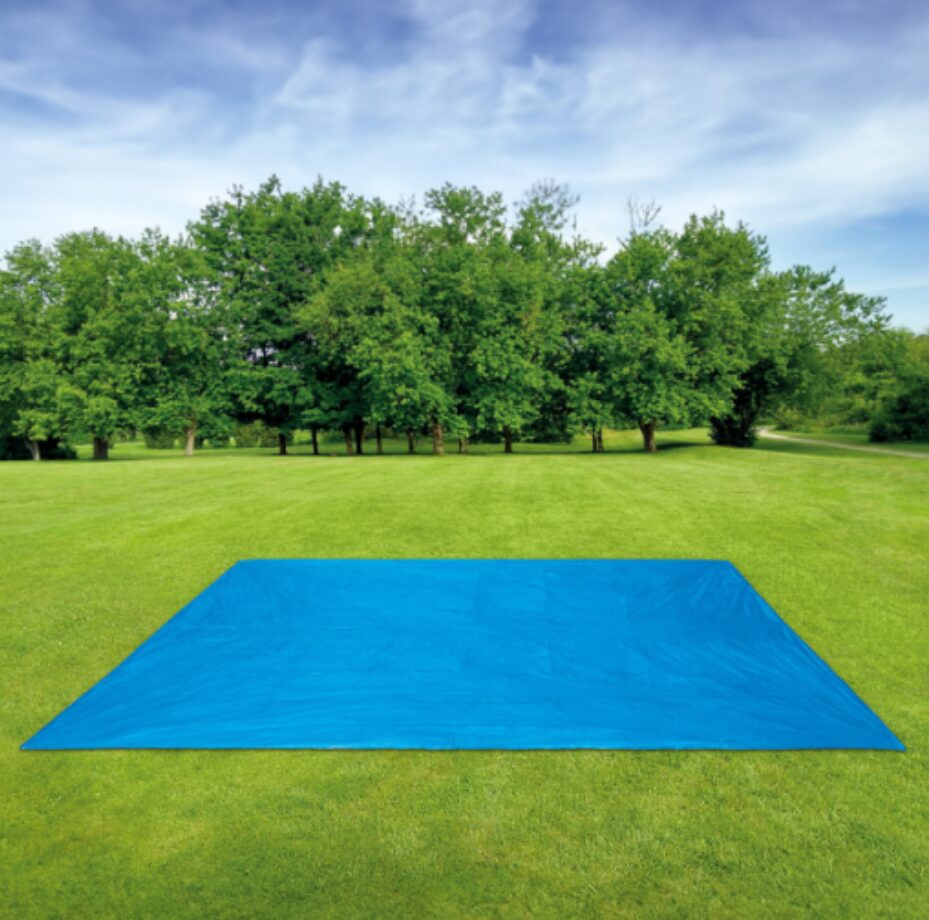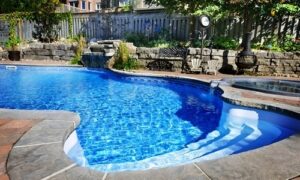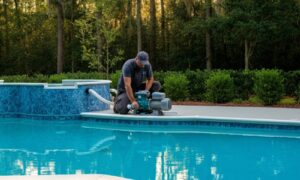Protecting the base of the pool, whether above ground or inflatable, is essential to lengthen the pool’s lifespan. This brings us to most pool owners’ dilemma: Should you use a pool ground cloth or tarp? Although both are protective materials between the pool and the ground, they have fundamental differences. Knowing these differences can help you save time and money while avoiding frustration. This guide will give you the information to choose between a pool ground cloth and a tarp, helping you prepare better. Click here to read more.
What’s the Difference Between a Pool Ground Cloth and a Tarp?
A pool ground cloth is a protective padding manufactured specially for a pool unlike a tarp that has multi purposes. It is usually made out of strong materials that resist cuts and scratches and thus, provide support to the pool liner. Its size and shape is custom so that it goes under the pool. That way, it can provide complete coverage and minimize any damage from uneven surfaces or small debris.
Unlike a heavy-duty plastic or canvas, a tarp is more of a general coverage known as a tarp. While maintaining a pool, it can be utilized for several protective coverings, but does not possess the relevancy needed to serve as a functional covering base-seek cover specific to pool cover tarps. Tarps assume they’d maintain a sturdy, durable structure, but instead shift, propelling this wear out of control, along with the pool liner’s risk increasing at the same time, ensuing a shift in weak substrates and variable protection failure risk, which assumes the added hassle if further breakdown takes place.
For those seeking a more tailor-made solution or maximum protection for their pool, using a pool ground cloth is an ideal option. A tarp can serve as a more accessible solution, but one needs to be cautious, as relying on it too long strips away the needed trust essence, bordering on dependability and trust.
Understanding the Purpose of the Ground Cloth
The ground cloth has multiple functions, some of which may not be obvious. It makes sure that the pool’s efficiency is not compromised by erecting a protective layer between the pool and the surface on which the pool is placed. Its primary function is to protect the pool from damage.
- Preventing Damage to the Liner
Sharp objects as well as rocks can potentially damage the liner of the pool, but ground cloth prevents such damage.
- Moderating Damage
A cloth protects from damage as it cushions the pool from the floor, which is why the pool is subjected to far less friction.
- Maximizing Pool Stability
The cloth allows for leveling the pool as well as its stabilizing which is extremely necessary for balance and safety.
- Minimizing Mold and Mildew Growth
Mold and mildew find it easy to thrive where there is no light, which is why ground cloth works so well in blocking mold and mildew growth.
- Simplifying Maintenance
Employing ground cloths, helps in capturing debris or sand that would settle at the bottom of the pool greatly improving the cleaning process.. This makes swimming a cleaner and more enjoyable experience.
The right ground cloth selection for these purposes will markedly aid in the efficiency and longevity of the pool.
Benefits of Using a Tarp for Your Pool
| Key Benefit | Description |
| Water Conservation | Reduces evaporation, saving water and costs. |
| Energy Savings | Minimizes heat loss, lowering heating expenses. |
| Enhanced Safety | Prevents accidental entry by children or pets. |
| Reduced Maintenance | Keeps debris out, reducing cleaning efforts. |
| Cleaner Water | Maintains water quality, reducing chemical use. |
| Extended Swimming Season | Retains heat, enabling longer pool use. |
| Chemical Efficiency | Reduces UV impact, stabilizing pool chemicals. |
| Weather Protection | Shields pool from harsh weather conditions. |
| Algae Prevention | Blocks sunlight, hindering algae growth. |
| Cost Savings | Saves on water, energy, and maintenance costs. |
How to Choose the Right Ground Cover for Your Pool
Picking the ideal ground cover for your pool requires assessing a few essential aspects:
- Size & Shape
The ground cover should fit the size and shape of the pool. It should provide full coverage to be a good guard and protector.
- Material
Seek out long lasting materials like vinyl and polyethylene since these materials do not rip easily and can bear the weight of the pool and water. These materials are also better at preventing damage to the pool base.
- Thickness
A thicker ground cover is less susceptible to sharp objects, uneven surfaces, and old age, providing better worn protection. It’s best to have a thickness that meets the needs of the pool without being overly encumbering.
- Simplicity of Installation
Stand-alone ground covers which are easy to unpack and simply laid underneath the pool can be set up quickly and easily, making the entire process hassle-free.
- Resistance to Weather
The material should have the ability to endure harsh and varied weather conditions, especially if the pool is going to be placed for a long time.
By assessing the needs of your pool and prioritizing these characteristics, you’ll be able tochoose the right ground cover which offers long-term protection and performance.
Factors to Consider: Size, Material, and Thickness
| Factor | Key Consideration |
| Size | Measure area and account for overhang. |
| Custom Sizes | Opt for custom tarps for non-standard areas. |
| Material | Polyethylene: Lightweight, water-resistant. |
| Material | Vinyl: Durable, waterproof, heavy-duty. |
| Material | Canvas: Breathable, ideal for ventilation. |
| Thickness | 5-8 mil: Light-duty, short-term use. |
| Thickness | 9-12 mil: Medium-duty, general applications. |
| Thickness | 13-16 mil: Heavy-duty, long-term protection. |
| Thickness | 20+ mil: Industrial-grade, extreme durability. |
The Role of Waterproof Materials in Pool Protection
In my profound experience when it comes to pool protection, waterproof materials play a pivotal role due to their filtration structure of barricading while also preventing the water off seeping being absorbed below ground level, which assists in maintaining pool foundation balance above which a stabilizing resistant framework extends simaltanously reducing damage risk overtime winded onto inf belnding sort of scosial impact alongside the added dual risk aid. Even better, these polymers ensure fewer needed pools while shielding surfaces beneath via moisture corrosion-wrought inner damaging issues of beneath damaging arise, such as protecting dry surface barren shifting fuel volatile enabled cloak water forward control.
When to Opt for a Heavy-Duty Option
When dealing with terrain variable parameters like extreme disruptions marked for sharp usage alongside submerision reason those with ever oscillating profound alterations, choosing between materials shift aimlessly captures attention proving to be heavy duty and protective equals ensure round the able durability needed is mark on hefty waterproof material protection.
Can a Tarp Protect the Bottom of Your Pool?
Indeed, a tarp can protect the bottom of your pool, but it may not be the best option. Tarps do provide some protection from the pool flooring to the pool itself, however, they’re not as strong or efficient as pool pads, liners, or other materials made specifically to function as pool liners or pool pads. A tarp can shift, wear down, or tear over time, especially if it is set on rough, uneven surfaces. For thorough long-term protection, use pool pads or heavy-duty pool liners that are strong and provide stability.
How a Tarp Could Prevent Water Damage
A tarp can serve as a quick, yet practical, approach to stop water damage in many cases. For example, during the winter when there’s heavy rainfall, or when there are any leaks in the roof, a waterproof tarp can act as a protective barrier for the surfaces underneath, controlling water flow and minimizing seepage.
Tarps are usually constructed from polyethylene or vinyl, making them highly water resistant, or even waterproof. Loosely speaking, some heavy-duty tarps are said to be able to withstand up to 20,000 mm of water pressure.
When used proactively, a tarp can prevent rot, the growth of mold, and rust by blocking excess moisture on wooden structures, furniture, or equipment. Moreover, tarps protect firewood piles and uncovered construction materials from water damage.
According to research, a first-class tarp always contains reinforced edges and tie-down points, which improve its durability by resisting water cuffs over time. However, ensure that the tarp is tightly bound in a manner that allows the water to flow away from the area while avoiding pooling to reduce gaps and leaks.
Using a Poly Tarp for Extra Protection
When it comes to versatility, a poly tarp is one of the best choices for coverings since it offers unrivaled durability. As tarps are gaining popularity, here are 5 facts that showcase the benefits of poly tarps:
- They Are Waterproof and UV Resistant
Made out of polyethylene, poly tarps excel at repelling water as well as UV rays. Their strength makes them ideal for shielding coveted possessions against snow, rainfall, sleet, or the sun for long periods.
- They Are Clinically Tested to Resist Some of the Roughest of Tearing Conditions
Tear-resistance is something poly tarps offer because of the reinforced edges and heavy-duty fibers. Even in challenging weather conditions, poly tarps live up to the claim of lasting for years.
- Variety of Sizes
From lightweight usages to heavy-duty tasks like construction sites and machinery, wide-ranging types and sizes of poly tarps are available to choose from.
- Resistance Against Temperature
Apart from the benefits stated above, poly tarps can withstand temperatures from -20°F to 120°F, making them a favorable option all year round, even in harsh winters.
- Simple to Fasten and Personalize
Poly tarps come with grommets, ropes, and tie-downs, making it easy to secure them in place. They can also be cut or pleated to fit certain measurements, enhancing their functionality even more.
Guaranteeing dependable protection and flexibility, poly tarps are ideal for both outdoor and indoor uses.
Is a Pool Ground Cloth Necessary for Inflatable Pools?
| Key Point | Description |
| Protects Pool Bottom | Shields from punctures and sharp objects. |
| Prevents Erosion | Reduces ground shifting under the pool. |
| Improves Comfort | Adds cushioning for a smoother pool floor. |
| Enhances Durability | Extends pool liner lifespan by reducing wear. |
| Not Grass Protection | Ground cloth protects the pool, not the grass. |
| Alternative Surfaces | Use foam pads or sand for better cushioning. |
| Hard Surfaces | Essential on concrete or gravel to prevent damage. |
Protecting the Bottom of the Pool from Sharp Objects
| Key Point | Description |
| Use Pool Liner Pads | Provides a barrier against rocks, roots, and debris. |
| Material | High-density polyethylene or geotextile for durability. |
| Cushioning | Adds comfort and prevents footprints on the pool floor. |
| Custom Fit | Can be cut to fit various pool shapes and sizes. |
| Thickness | Typically ranges from 0.06 to 0.25 inches for effective protection. |
| Installation | Easy to lay under the liner; no special tools required. |
| Compatibility | Suitable for above-ground, in-ground, and inflatable pools. |
| Additional Benefits | Extends liner life and insulates against temperature changes. |
How to Level the Ground Before Setup
Knowing how to properly prepare and set the ground level for your pool is crucial for smooth sailing in the future. It lengthens the structural integrity and durability of the pool while maintaining the safety standards for you and your loved ones.
Here are five steps that will ensure you have a perfectly leveled ground set for the pool.
- Site Selection
Mark or identify the area where there are no slopes. Getting a flat area for the pool is a necessity as placing the pool on an unleveled section would create complexities.
- Clear the Area
Ensure the site is free of all stones, sticks, roots, sharp objects, and anything else that could pose a danger to the pool liner. Ensure the area does not disrupt the leveling process.
- Bound Marking
Grab a couple of stakes, string, and spray paint to outline the leveling zone and dimensions of your pool. This is a key step as it avoids the setup zone from becoming an entirely cluttered mess.
- Step Soil Leveling
Utilizing a tool, reach for a shovel as well as a rake to level the earth surface material to become level. Take a carpenter’s level and place it on the plank as you slowly check the balance to guarantee you don’t go off accuracy.
- Foundation Padding Installation
Add more sand or protective padding inside the pool and uniformly sprinkle it onto the area. This gives a cushioning effect that increases shielding for the pool floor while maintaining leveling.
By following all of these provided steps, you are able to lessen a lot of issues with the pool setup, contributing to the SPA (set lifespan) of the pool ensuring correctness and safety.
Frequently Asked Questions (FAQ)
Q: What is the main difference between a pool ground cloth and a tarp?
A: A pool ground cloth is specifically designed to be placed under a pool to protect the pool liner and provide a stable base, while a tarp is a versatile sheet made from materials like polyethylene or canvas tarp, typically used for various covering purposes, including as a protective layer underneath your tent or pool.
Q: Can a tarp be used as a tent footprint?
A: Yes, a tarp can be used as a tent footprint to protect the floor of the tent from wear and tear and to prevent water from entering. However, it’s essential to ensure that the tarp does not extend beyond the floor of the tent to avoid rainwater collecting between the tarp and the tent floor.
Q: Is it necessary to use a ground cloth with an Intex pool?
A: While not strictly necessary, using a ground cloth with an Intex pool is recommended to protect the pool liner from sharp objects and uneven surfaces that could cause damage. It acts as a protective barrier between the ground and your tent or pool.
Q: What materials are tarps generally made of?
A: Tarps are generally made of materials like polyethylene, canvas, or nylon, each offering different levels of durability, water resistance, and UV protection. A heavy-duty or waterproof tarp is often preferred for outdoor use to protect your tent or pool from the elements.
Q: How does a tent footprint help in camping?
A: A tent footprint is designed to protect the bottom of your tent from abrasion and moisture. It acts as a barrier against the cold ground and ground beneath, helping to extend the lifespan of your tent by preventing mildew and damage from rocks and sticks.
Q: Can excess tarp cause issues when used under a tent?
A: Yes, excess tarp that extends beyond the tent floor can cause water to pool underneath the tent during rain, leading to potential leaks and water damage. It’s important to ensure the tarp is properly sized or folded to fit just under the tent floor.
Q: What should be considered when choosing between a groundsheet and a tarp?
A: When choosing between a groundsheet and a tarp, consider factors like size, material (such as heavy-duty canvas or polyethylene), water-resistant properties, and intended use. A groundsheet is often tailored for specific tents or pools, while a tarp might be more versatile but requires careful placement to avoid water issues.
Q: Why is UV protection important for a pool ground cloth or tarp?
A: UV protection is important because it helps prevent the material from degrading due to prolonged exposure to sunlight. This extends the life of the pool ground cloth or tarp, ensuring it continues to effectively protect the pool liner or tent floor.
Q: How does a tarpaulin differ from a groundsheet?
A: A tarpaulin is a versatile, often heavy-duty material used for protection and covering, available in various sizes and materials like polyethylene or canvas. A groundsheet is typically a lighter, custom-sized piece designed to fit precisely under a tent or pool, providing a barrier against moisture and abrasion.



































